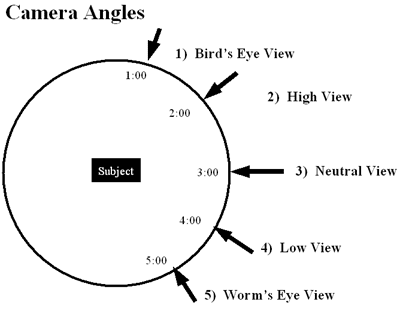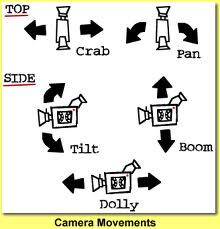1) Bird’s-eye view:
A Bird’s-eye view shows a scene from overhead. Overhead of your character or even to show the setting but the shot doesn’t show anything as clearly as you may think it is. This camera shot makes the audience feel like ‘God’ as God watches over everything that happens over our heads. People would look as tiny as ants and that also makes the audience feel tall and proud.
A Bird’s-eye view shows a scene from overhead. Overhead of your character or even to show the setting but the shot doesn’t show anything as clearly as you may think it is. This camera shot makes the audience feel like ‘God’ as God watches over everything that happens over our heads. People would look as tiny as ants and that also makes the audience feel tall and proud.
2) High Angle:
This angle is similar to the Bird’s-eye view but not as high up. The camera is slanted in the action, hovering over the sides of the heads. This makes whatever you are trying to focus on smaller and insignificant. This action becomes part of a wider scale.
This angle is similar to the Bird’s-eye view but not as high up. The camera is slanted in the action, hovering over the sides of the heads. This makes whatever you are trying to focus on smaller and insignificant. This action becomes part of a wider scale.
3) Eye Level:
The eye-level shot is placed in level with a character’s face as if the audience is watching in level with the focus.
The eye-level shot is placed in level with a character’s face as if the audience is watching in level with the focus.
4) Low Angle:
Low angles are mainly used to give an effect of how small you are to the world. Low angles shots give a sense of powerlessness and makes you feel useful in the scene and this type of camera angle would be useful for short actors like Danny Devito or Tom Cruise.
Low angles are mainly used to give an effect of how small you are to the world. Low angles shots give a sense of powerlessness and makes you feel useful in the scene and this type of camera angle would be useful for short actors like Danny Devito or Tom Cruise.
5) Oblique/Canted Angle:
An Oblique/Canted Angle can be sometimes tilted which is used in many popular horror movies to indicate to the audience that the scene is unstable, or ‘something is going to go wrong’. This shot suggests the ‘point of view’ of a character.
An Oblique/Canted Angle can be sometimes tilted which is used in many popular horror movies to indicate to the audience that the scene is unstable, or ‘something is going to go wrong’. This shot suggests the ‘point of view’ of a character.














